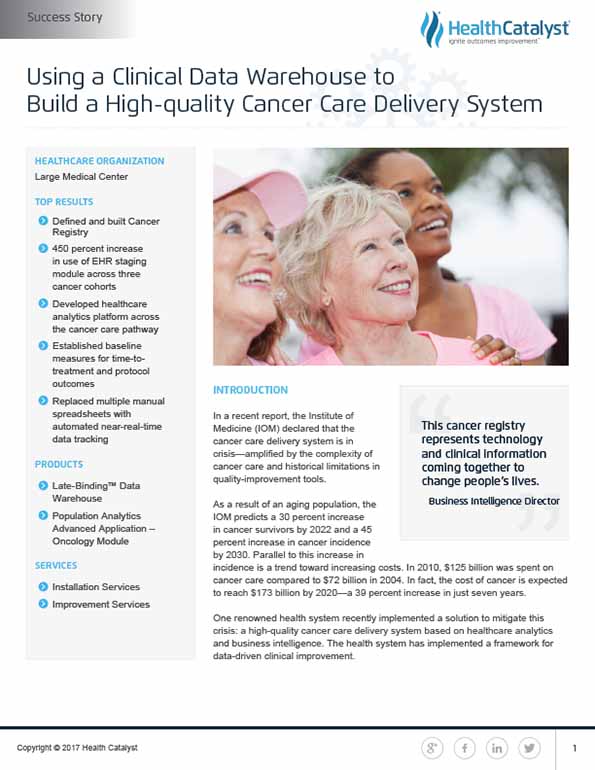The Institute of Medicine reports a crisis in cancer care due to increasing complexity and costs, predicting a 30 percent rise in survivors and a 45 percent increase in incidence in the coming years. This health system implemented a high-quality cancer care delivery system based on healthcare analytics and business intelligence, along with a framework for data-driven clinical improvement to help mitigate the crisis.
In a recent report, the Institute of Medicine (IOM) declared that the cancer care delivery system is in crisis—amplified by the complexity of cancer care and historical limitations in quality-improvement tools.
As a result of an aging population, the IOM predicts a 30 percent increase in cancer survivors by 2022 and a 45 percent increase in cancer incidence by 2030. Parallel to this increase in incidence is a trend toward increasing costs. In 2010, $125 billion was spent on cancer care compared to $72 billion in 2004. In fact, the cost of cancer is expected to reach $173 billion by 2020—a 39 percent increase in just seven years.
One renowned health system recently implemented a solution to mitigate this crisis: a high-quality cancer care delivery system based on healthcare analytics and business intelligence. The health system has implemented a framework for data-driven clinical improvement.
With evidence showing better outcomes for women with Stage II breast cancer who begin treatment within two weeks of diagnosis, this healthcare organization began examining its own treatment protocols. It quickly discovered that its electronic health record (EHR) could not provide actionable information on cancer care in a timely, repeatable way.
For many physicians, free-text documentation is the preferred way to capture the complete patient story. Although oncologists were capturing cancer-specific details (such as staging data) in the EHR, they were doing so in the form of free-text notes. This practice resulted in inconsistent, unstructured data that could not be used to analyze care or outcomes.
“For over six years, the EHR informatics team had been working—unsuccessfully—to get oncology physicians to record patients’ cancer staging in structured fields, but they always resorted to documenting the information in progress notes,” said a clinical informatics specialist.
When an oncology physician wanted to know the organization’s time-to-treatment for Stage II breast cancer, not only could she not access staging data, she could not even isolate cancer patients using cancer-specific diagnosis codes. The EHR captured—but did not connect—the discrete data elements, and there was no way to access other cancer-specific fields buried in unstructured treatment notes. Individual departments used their own manual spreadsheets to track data for regulatory reporting.
To get the data it needed, the hospital implemented Health Catalyst’s Late-Binding™ Clinical Data Warehouse. The EDW integrates data from source applications—clinical, financial and more—and makes it available for reporting and analysis.
The EDW aggregated data from the existing EHR and other sources into an analytics platform for monitoring the cancer patient’s journey across the care pathway. Working closely with the organization to identify key data elements and then finding where they were captured in the EHR, Health Catalyst helped the organization define and build its own cancer registry.
With the EDW foundation in place, Catalyst deployed an advanced analytics application specific to cancer care to run on the platform. The health system is using this Oncology Module to track metrics such as:
The application presents metrics in easy-to-understand summary visualizations and also allows clinicians and other users to drill down into the data for deeper analysis.
One of the many benefits of the EDW has been the ability to track the use and effectiveness of various treatment protocols. Although the hospital had preferred protocol templates, the data revealed that physicians’ customization had resulted in several hundred different templates being used.
The EDW enabled the hospital not only to track which protocols were being used by which clinician, but also to track the incidence of ED or urgent inpatient admissions after receiving a specific treatment protocol—a useful indication of the protocol’s relative effectiveness.
However, because clinicians were only documenting staging data in discrete EHR fields for 4 percent of patients, this outcomes data was limited. Oncology department leaders decided to use this fact to promote improvement in staging documentation.
“As both an RN and a Business Intelligence Analyst, I couldn’t be more excited about the innovative work we’re doing. This is about using business intelligence hand in hand with clinical data; about moving beyond theory to reality; about complementing doctors’ gut instincts with evidence-based medicine. I have colleagues I’d like to refer to Health Catalyst.”
– Business Intelligence Director
Department leaders showed physicians the outcomes data and pointed out the limitations that incomplete staging documentation imposed on the process. With the promise of increased data availability and outcomes-driven motivation to change documentation practices, these leaders convinced physicians to input staging data in the EHR—something they had never been able to achieve in the previous six years of trying.
“The EDW allowed us to demonstrate value in the EHR data,” the clinical informatics specialist noted. “The physicians could actually see the huge potential of having accurate staging data in the system.”
With the EDW, one cancer cohort’s staging documentation—breast cancer—increased from 4 to 40 percent. Across all three cancer cohorts currently being measured, documentation has increased by 450 percent (from 4 to 22 percent). The health system’s goal is to reach 90 percent compliance within 60 days, and current trend data indicates that they are on track to achieve it.
The hospital plans to leverage the EDW platform and Advanced Analytics Application for several clinical improvement projects, including:


